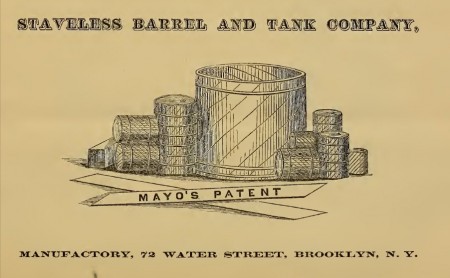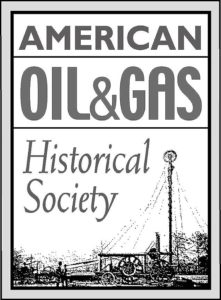The brief oilfield journey of a “staveless” wooden barrel maker.
The U.S. petroleum industry was barely a decade old and as oil discoveries spread from northwestern Pennsylvania’s first commercial well, efficiently transporting the resource became critical. In Brooklyn, New York, the Staveless Barrel and Tank Company organized. The company hoped to exploit a new patent for making barrels.
Capitalized in 1867 at $500,000 with 5,000 shares at $100 each, Staveless Barrel and Tank’s barrel-making process included, “application of scale-boards or veneers in layers, the direction of whose grain is crossed or diversified, and which are connected together, forming a material for the construction, lining, or covering of land and marine structures.”
To attract potential investors as well as oilfield customers, the company prospectus declared: This Company holds the patent for the manufacture of absolutely tight Tanks, Cisterns, Hogsheads, Puncheons, Barrels, Kegs and Boxes. The want of such an article has long been felt throughout the country, but in no place so much as in the Oil Districts, where millions of gallons are annually lost through imperfect packages.

The laminated products of Staveless Barrel and Tank Company originated in 1865 with a U.S. patent by John K. Mayo of Portland, Maine.
With oil region refineries — and many new ones in Pittsburgh — needing oil to meet soaring demand for making kerosene the lamp fuel, the company planned to exploit a December 26, 1865, U.S. patent awarded to John K, Mayo (No. 92,332) for his “Improved Process and Apparatus for Manufacturing Composition Pipes, Tubes, Barrels, etc.”
Mayo’s barrel design reportedly produced dependable, leak-proof laminated barrels for as little as $2.50 each — but Staveless Barrel & Tank did not survive the highly competitive oilfield service industry.
Meanwhile, despite booming oilfield and the introduction of pipelines and railroad tank cars, there remained strong demand for durable, leak-proof barrels.
Traditional wooden barrels had always been problematic for shipping oil even before a group of oilmen met in Titusville, Pennsylvania, in 1866 and agreed to a standardized size. Not until 1902 did Standard Oil introduce a steel version of the common 42-gallon oil barrel — and keeping the traditional bilged appearance.
Famous New York World journalist Nellie Bly’s 1905 patent ultimately evolved into today’s ubiquitous 55-gallon drum. Read more in The Remarkable Nellie Bly.
The Staveless Barrel and Tank Company’s late-1860s stock certificates have some collectible value (see Scripophily). More stories of petroleum exploration and production companies joining petroleum booms — and avoiding busts — can be found updated in Is my Old Oil Stock worth Anything?
_______________________
The American Oil & Gas Historical Society (AOGHS) preserves U.S. petroleum history. Please become an AOGHS annual supporter and help maintain this energy education website and expand historical research. For more information, contact bawells@aoghs.org. Copyright © 2025 Bruce A. Wells.
Citation Information – Article Title: “Staveless Barrel and Tank Company.” Authors: B.A. Wells and K.L. Wells. Website Name: American Oil & Gas Historical Society. URL: https//aoghs.org/old-oil-stocks/staveless-barrel-and-tank-company. Last Updated: April 1, 2025. Original Published Date: August 26, 2013.


